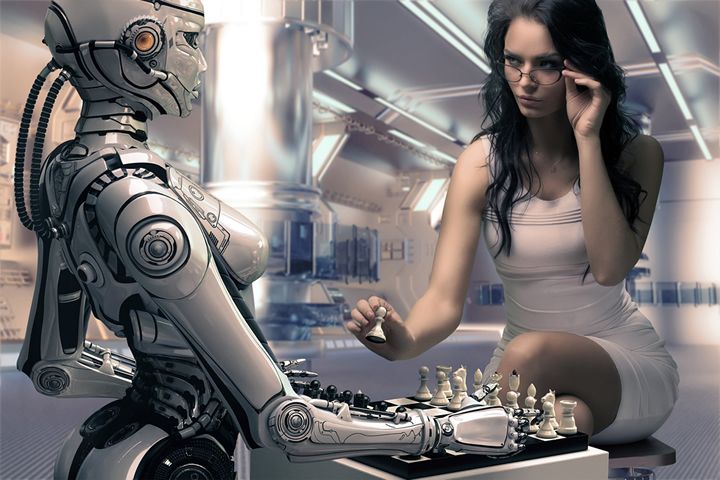Advanced humanoid robots are not destined to replace human workers entirely. Instead, they are poised to revolutionize industries by complementing human skills and addressing critical labor shortages in hazardous environments.
 The Future of Work: How Humanoid Robots Will Revolutionize Industries
The Future of Work: How Humanoid Robots Will Revolutionize Industries

Article from | Humanoid
While alarmist rhetoric and fear-mongering headlines about humanoid robots threatening jobs are abundant, such fears may be misplaced. In reality, artificial intelligence and robotics technology are advancing rapidly, paving the way for humanoid robots to take on increasingly sophisticated roles across various sectors.
Rather than simply replacing human workers, these expanding capabilities promise to revolutionize industries from manufacturing to healthcare, potentially creating new opportunities and enhancing productivity in ways we’re only beginning to imagine.
Recently, rapid advancement of humanoid robotics has prompted some U.S. lawmakers to express concerns about potential security risks and economic implications. As widespread adoption may be imminent, now is the crucial moment to explore potential use cases for these advanced machines and consider their far-reaching consequences for the global workforce and international relations.
In HumaNoid, we are observing firsthand the transformative potential of this technology. Advanced humanoid robots are not destined to replace human workers entirely. Instead, they are poised to revolutionize industries by complementing human skills and addressing critical labor shortages in hazardous environments.
The dawn of a new workforce
Consider the manufacturing sector, where humanoid robots are already making significant inroads. At automotive plants, these machines can work alongside human employees, handling heavy components and performing repetitive tasks with precision. This not only increases efficiency but also reduces the risk of injury to human workers.
Another compelling use case is in disaster response. When earthquakes, floods, or industrial accidents occur, humanoid robots can be deployed to assess damage and perform rescue operations in environments too hazardous for human first responders. This capability was demonstrated during the 2011 Fukushima nuclear disaster, where robots were used to explore contaminated areas and assist in cleanup efforts.
Addressing global labor needs
According to the latest data, there are currently 8.1 million job openings in the U.S. but only 6.8 million unemployed workers available to fill these positions. Up to 70% of these job openings are essential roles in warehouses, manufacturing, transportation, and retail.
In many developed countries, aging populations and declining birth rates are leading to workforce gaps in essential sectors. By 2050, the proportion of the global population aged 65 and above is expected to rise to 16%, up from 10% in 2022. This means that more than one in six people across the globe will be over 65.
In healthcare, for instance, humanoid robots could be deployed to assist nurses and caregivers, performing tasks like lifting patients or delivering medications. This would allow human healthcare workers to focus on more complex, empathetic aspects of patient care.
Similarly, in agriculture, humanoid robots could help address labor shortages during harvest seasons. Their ability to navigate uneven terrain and handle delicate produce with precision makes them ideal for tasks like fruit picking or crop monitoring.
Emergence of new job categories
The rise of humanoid robots will create a demand for various new job categories. We’ll need robot trainers and programmers to teach these machines new tasks and optimize their performance. Maintenance technicians will be crucial to keep the robots in good working order. Ethics and safety specialists will play a vital role in ensuring the responsible deployment of this technology. Additionally, human-robot interaction designers will be necessary to create intuitive interfaces that facilitate seamless collaboration between humans and robots. These emerging roles highlight the shift towards a workforce that combines human expertise with robotic capabilities.
Moreover, as robots take on more dangerous and repetitive tasks, human workers will be freed to focus on roles that require creativity, emotional intelligence, and complex problem-solving – skills that remain uniquely human.
Creating a workforce for the AI era
Involving workers in the design and implementation process can lead to more effective integration and reduce resistance. Simultaneously, developing clear ethical guidelines for robot use, addressing privacy, safety, and job displacement concerns, is essential. By thoughtfully managing this transition, we can harness the benefits of humanoid robots while mitigating potential negative impacts on the workforce.
The human touch in a robotic world
For instance, in a manufacturing setting, humanoid robots might handle the physical assembly of products, while human workers focus on quality control, process improvement, and customer interaction. This symbiotic relationship allows for increased productivity while maintaining the flexibility and problem-solving capabilities that humans excel at.
New era of human liberation
The future of work is not about humans versus robots, but rather humans and robots working together to tackle the challenges of the 21st century. As leaders in industry and technology, it’s our responsibility to guide this transition in a way that benefits workers, businesses, and society as a whole.
At HumaNoid, we see the integration of humanoid robots into our workforce as more than just technological advancement; it heralds a profound shift in our societal structure and human potential.
This idea is reflected in our vision: we believe in a future where humans and machines together build a new history filled with knowledge, inspiration, and spectacular discoveries.
As these advanced machines take on repetitive, dangerous, and undesirable tasks, we stand on the brink of a new era of human liberation.
This technological revolution is not only promising to address critical labor shortages in essential industries– it will also help liberate individuals to pursue more fulfilling and creative endeavors.
Our vision for what humanoid robots can be extends beyond mere efficiency gains, encompassing a future where universal basic income becomes feasible, poverty is significantly reduced, and human beings are empowered to choose their life’s work based on passion rather than necessity.
By deploying humanoid robots in hazardous or monotonous environments, we not only safeguard human well-being, but also pave the way for a society where abundance is the norm and human potential can be fully realized.
Just as many are becoming disenchanted in the limits of capitalism, this new AI era is already ushering unprecedented advancements in knowledge, learning, and discovery. It could be just the thing to allow humans and machines to collaboratively build a future of shared prosperity and innovation.
The content & opinions in this article are the author’s and do not necessarily represent the views of RoboticsTomorrow
Featured Product


.jpg)